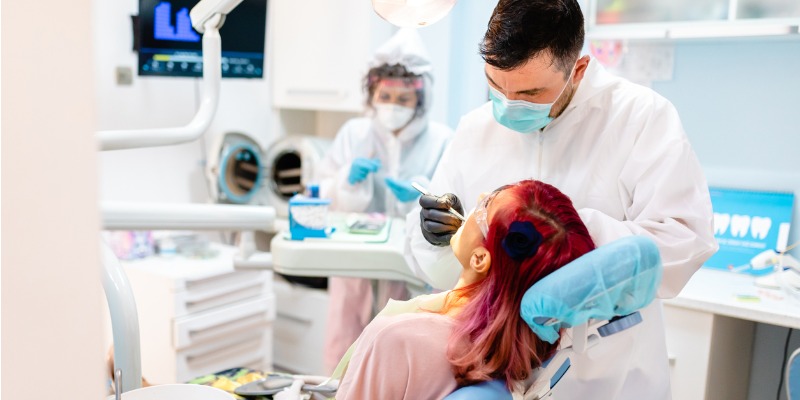Specialist dentistry can be confusing for the average person. A specialist is a dentist with at least two years of experience, followed by at least three years of postgraduate study. In Western Australia, dentists complete their three years of post-grad full-time study at the University of Western Australia.
Specialist Dentistry
Orthodontics and periodontics are just two of 13 areas of dental specialization. These two specialties often work together to help patients treat aesthetic concerns, or tooth and gum issues.
What Does a Periodontist Do?
A periodontist is a specialist dentist that diagnoses and treats diseases and disorders that affect the soft tissue and bones that support the teeth. They complete diagnostic, non-surgical and surgical services that improve dental health and aesthetics.
Treatment services include:
- Dental implants.
- Complications of dental implants such as peri-implantitis.
- Treating gingivitis through to severe periodontal disease.
- Scale and root planing.
- Gum graft and tissue surgery.
What Does an Orthodontist Do?
An orthodontist specializes in diagnosing and correcting alignment problems in teeth and jaws. An orthodontist treats misaligned teeth caused by an abnormal bite, crooked, overlapping or crowded teeth.
Treatment services include:
- Diagnosis and treatment of crooked teeth or space between teeth with braces or Invisalign.
- Diagnosis and treatment of bad bites with braces or Invisalign.
- Preventative treatments such as palate expanders.
- Facial growth and dental development.
Which Specialist Dentist Should You See First?
Deciding which specialist you see first will depend on advice from your dentist. To see a periodontist, you need a referral from your regular dentist. However, a referral is not required for an orthodontist.
If you ask to be referred to an orthodontist, your dentist will complete a routine check of your mouth to look for any potential problems. If your dentist knows or suspects that gum disease (periodontal disease) is present, or you have a problem with your jaw, they may recommend you see a periodontist first. A periodontist can confirm if you have any dental issues that need to be treated before orthodontic treatment can begin.
An orthodontist won’t apply braces to a patient with gum or jaw bone issues because the problem can worsen once teeth start moving. A patient is at risk of permanent dental problems if orthodontic treatment begins or continues with gum disease.
Treatment Provided By a Periodontist
Unhealthy and diseased gums can be treated in several different ways:
Scale and Root Planing
Gum disease can be treated with deep cleaning, which involves scraping off plaque and tartar from teeth. Known as scaling, the hardened material and bacteria are removed. When clean, the patient can brush twice daily and floss to keep teeth clear of build-up in the future.
Some patients require root planing to smoothen teeth roots. Having smooth teeth makes it easier for roots to reattach to the gum-line.
Antimicrobial or antibiotic treatments may be needed to ensure the bacteria on teeth doesn’t cause serious health problems. Local anesthesia is often used during scaling and root planing. Both procedures can be done in the chair rather than in the hospital.
Gum Pocket Surgery
Periodontal disease causes gum tissue to detach from teeth. The space between teeth and gum are called pockets. Bacteria can thrive deep inside the pockets where it’s impossible to clean with a brush. Even a dentist can’t clean deep pockets – only a periodontist can to eliminate the bacteria and inflammation. If left untreated, the bacteria can cause tissue and bone loss. When the gums are healthy, the patient can begin orthodontic treatment.
Tissue Grafts
In severe cases of periodontal disease or in older patients, a gum graft may be needed to protect teeth from a receding gum line. When teeth aren’t protected from gums, the exposed roots can be sensitive. Often, gum tissue doesn’t repair itself. A graft is needed to improve the gum’s health. A periodontist may use tissue from the palate or a synthetic material.
Once a periodontist has repaired the gums, the patient can see the orthodontist to begin treatment.
Can Orthodontists Refer Patients to a Periodontist?
Yes – some patients may see an orthodontist who then refers them to a periodontist. If a patient hasn’t seen their dentist for some time, early gum disease or gingivitis may be present. The orthodontist may want it treated before they can begin. During the first consultation, an orthodontist may take x-rays that reveal a jaw bone issue. The orthodontist may then refer the patient to a periodontist for their opinion before treatment can begin. In some cases, a gum problem may even appear during orthodontic treatment that requires a periodontist.
Some patients need aesthetic treatment by both a periodontist and orthodontist. A missing tooth may be replaced by an implant. In this case, a periodontist will prepare the implant and complete the surgery to fit the screw into the jaw that holds the implant in place. An orthodontist may also improve the appearance of natural teeth with braces.
When to See A Periodontist vs Orthodontist
In most young orthodontic cases, the patient doesn’t need to see a periodontist. If they have cared for their teeth by brushing twice daily, there’s not as much build-up of plaque to cause gum disease. All of their natural teeth are in place, so there’s no need for an implant.
Many older patients may need the services of a periodontist only. They may have lost a tooth that they want replaced with an implant that matches the natural teeth. Age is a major factor in causing gum disease. Older patients are more likely to undergo treatment for gum pockets to preserve their teeth and don’t want orthodontic treatment.
If you’d like to discuss your treatment options, don’t hesitate to speak with a specialist by calling your nearest orthodontists: https://caortho.org/locations?zip=92374&d=5
Source: https://www.theorthodontists.com.au/blog/periodontist-vs-orthodontist-who-you-should-see-first

